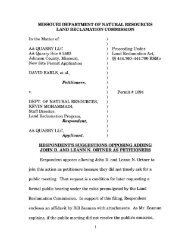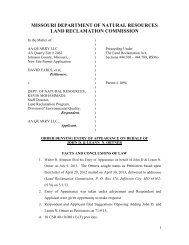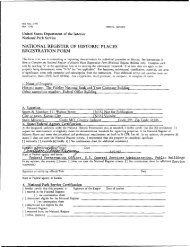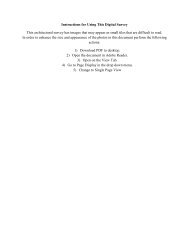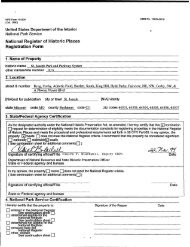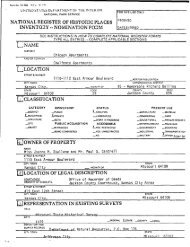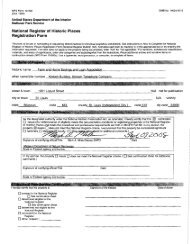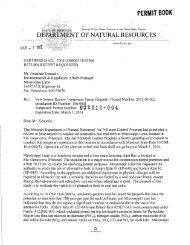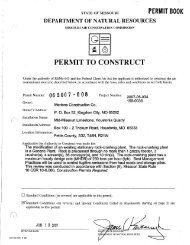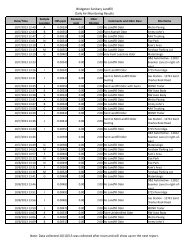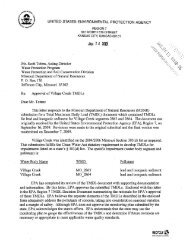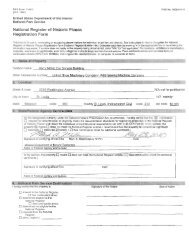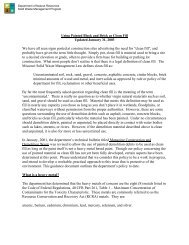Management of Nonfriable Asbestos Containing Materials - Missouri ...
Management of Nonfriable Asbestos Containing Materials - Missouri ...
Management of Nonfriable Asbestos Containing Materials - Missouri ...
Create successful ePaper yourself
Turn your PDF publications into a flip-book with our unique Google optimized e-Paper software.
<strong>Management</strong> <strong>of</strong> <strong>Nonfriable</strong> <strong>Asbestos</strong><br />
<strong>Containing</strong> <strong>Materials</strong><br />
Air Pollution Control Program fact sheet<br />
2/2009<br />
Disclaimer: The statements in this document are intended solely as guidance. This document is<br />
not intended, nor can it be relied on, to create any rights enforceable by any party in litigation.<br />
This guidance may be revised without public notice to reflect changes in law, regulation or policy.<br />
Introduction<br />
This document is one in a series <strong>of</strong> fact sheets designed to assist you in becoming aware <strong>of</strong> the<br />
department’s asbestos requirements. This particular document contains information regarding<br />
how to properly remove and dispose <strong>of</strong> nonfriable asbestos containing materials.<br />
Categories <strong>of</strong> <strong>Asbestos</strong> <strong>Containing</strong> <strong>Materials</strong><br />
There are three categories <strong>of</strong> asbestos containing materials, or ACM. These materials should<br />
be identified by a certified inspector prior to any renovation or demolition activities. They are as<br />
follows:<br />
• Friable asbestos containing material<br />
Any material containing more than one percent asbestos that, when dry, can be crumbled,<br />
pulverized or reduced to powder by hand pressure. Examples <strong>of</strong> friable materials include<br />
sprayed or troweled materials such as acoustical ceiling spray or boiler insulation, paper pipe<br />
insulation and drop-in ceiling tile.<br />
• Category I nonfriable asbestos containing material<br />
<strong>Asbestos</strong> containing packings, gaskets, *resilient floor covering and asphalt ro<strong>of</strong>ing products<br />
containing more than one percent asbestos. *(Any vapor barrier on resilient floor coverings is<br />
considered friable asbestos.)<br />
• Category II nonfriable asbestos containing material<br />
Any nonfriable material, other than category I materials, that contain more than one percent<br />
asbestos. Examples <strong>of</strong> category II materials include asbestos cement wall or ro<strong>of</strong> shingles<br />
and cement pipe.<br />
Depending on the type or category <strong>of</strong> asbestos containing materials present on a project and the<br />
work practices used during demolition or renovation to remove them, the materials may or may<br />
not be regulated by the department’s asbestos requirements. To determine the applicability <strong>of</strong><br />
the department’s asbestos requirements, one must determine if the asbestos from your project<br />
will meet the definition <strong>of</strong> Regulated <strong>Asbestos</strong> <strong>Containing</strong> Material, or RACM.<br />
Regulated <strong>Asbestos</strong> <strong>Containing</strong> Material includes friable asbestos containing materials; category<br />
I nonfriable materials that have become or will become friable or have been subject to sanding,<br />
grinding, cutting, abrading or burning; or category II nonfriable materials that have a high probability<br />
<strong>of</strong> becoming or that have become crumbled, pulverized or reduced to powder due to the work<br />
practices used during the course <strong>of</strong> demolition or renovation.<br />
PUB002156
Removal <strong>of</strong> Category I and II <strong>Nonfriable</strong> <strong>Materials</strong><br />
Most nonfriable materials are not regulated by the department, unless they are in poor condition<br />
or are rendered friable by improper work practices during demolition or renovation. Category I<br />
nonfriable materials can be left in place during demolition, provided the work practices used will<br />
not make the material friable. However, for certain types <strong>of</strong> category I materials, such as floor tile<br />
and linoleum, the department generally recommends their removal prior to demolition as these<br />
materials could easily be rendered friable during the demolition. Also, leaving these materials in<br />
place may increase the quantity <strong>of</strong> asbestos waste resulting in increased disposal costs. It<br />
should be noted that materials that contain or are coated with asbestos can not be used as<br />
clean fill materials. If Category I ACM is left in place, work practices must be implemented to<br />
ensure the material is not made friable during removal or demolition. Any activity that will result<br />
in the material being subject to sanding, grinding, cutting, abrading, or burning may cause the<br />
material to become subject to regulation, depending on the quantity <strong>of</strong> ACM involved.<br />
If a threshold or regulated quantity <strong>of</strong> RACM, including Category II materials, will be impacted,<br />
they must be removed prior to demolition or renovation activities. Category II materials must be<br />
removed in a manner that does not render the material friable. Improper work practices or<br />
materials in poor condition are considered RACM. If the material is crumbled, pulverized or<br />
reduced to powder during demolition or removal activities, the material may become subject to<br />
regulation depending on the quantity <strong>of</strong> RACM involved.<br />
Any project involving a threshold amount <strong>of</strong> RACM (160 square feet, 260 linear feet, or 35 cubic<br />
feet) must be performed by a registered asbestos abatement contractor. This includes situations<br />
where the material was originally nonfriable but is now in poor condition and situations<br />
where nonfriable materials will be made friable during demolition, renovation or removal.<br />
Examples <strong>of</strong> <strong>Nonfriable</strong> <strong>Materials</strong> and Acceptable Removal<br />
Techniques<br />
• Category I Asphalt Ro<strong>of</strong>ing Material is not regulated by the department as long as the material<br />
is in good condition and it is not made friable during removal or demolition. This material can<br />
generally be left in place during demolition activities, but still must be disposed <strong>of</strong> at a permitted<br />
landfill or transfer station. You should contact your disposal facility to determine how they<br />
will require this material to be packaged and delivered. Ro<strong>of</strong>ing material may be sliced by a<br />
manual cutter or knife, however, the use <strong>of</strong> mechanical devices such as a rotating blade ro<strong>of</strong><br />
cutter or other equipment will render ro<strong>of</strong>ing products friable. The U.S. Environmental |<br />
Protection Agency has determined that use <strong>of</strong> this kind <strong>of</strong> equipment on more than 5,580<br />
square feet <strong>of</strong> ro<strong>of</strong>ing will make the project subject to regulation. If this is the case, then the<br />
project must be performed by a registered asbestos abatement contractor in accordance with<br />
all applicable asbestos work practice requirements.<br />
• Category I Vinyl or Asphaltic Floor Tile is not regulated by the department as long as the<br />
material is in good condition and is not made friable during demolition or renovation activities.<br />
Tile can generally remain in place during demolition, but care must be taken to ensure the<br />
material is left largely intact. Since it is difficult to control the degree <strong>of</strong> breakage that may<br />
occur, the department generally recommends that floor tile be removed prior to demolition. Tile<br />
may be removed from a structure as an unregulated project if manual methods are used and<br />
the tile is removed in largely intact pieces. One acceptable nonfriable removal method would<br />
be to flood the tiled area with water to loosen the tile and then popping the material from the<br />
subfloor with a spud hoe. Breakage <strong>of</strong> the tile should be minimized. Other methods include<br />
the use <strong>of</strong> mastic reducers or an infrared heating device to loosen the tile from the glue or<br />
mastic before removing the tile with manual tools as discussed above. In both cases, the tile<br />
2
should be adequately wetted with amended water throughout the removal process and<br />
properly packaged while wet. This will help to reduce any potential asbestos emissions<br />
from the material.<br />
If the tile is not removed in largely intact pieces, even if removed by the manual methods<br />
discussed above, it will be considered RACM. In addition, the use <strong>of</strong> any mechanical devices<br />
or bead blasters for removing tile will subject the material to regulation as RACM. The removal<br />
<strong>of</strong> tile as RACM must be performed by a registered asbestos abatement contractor in<br />
accordance with all applicable asbestos work practice requirements.<br />
• Category I <strong>Nonfriable</strong> Mastic is not regulated by the department as long as the material is in<br />
good condition and is not made friable during demolition or renovation activities. This material<br />
must not be dry scraped or sanded. Use a mastic reducing solvent or material having a<br />
flashpoint above 140 degrees Fahrenheit to loosen the material from the subfloor. Then use a<br />
manual tool such as a spud hoe to remove the material. Any activity that would sand, grind,<br />
cut or abrade this material during removal would subject it to regulation as RACM. In this<br />
event, the project would be required to be performed by a registered asbestos abatement<br />
contractor in accordance with all applicable asbestos work practice requirements.<br />
• Category I Vinyl Sheet Flooring, or Linoleum, is not regulated by the department as long as the<br />
material is in good condition and is not made friable during demolition or renovation activities.<br />
Sheet vinyl on wooden subflooring can generally remain in place during demolition, but care<br />
must be taken to not disturb the vapor barrier as this material is considered inherently friable.<br />
Since most demolition activity will result in the backing being disturbed to some extent, the<br />
department would recommend that this material be removed prior to demolition. To remove<br />
sheet vinyl as a nonregulated project, the material must be removed adhered to the subfloor,<br />
so as to not expose the backing <strong>of</strong> the material. Exposure <strong>of</strong> the backing <strong>of</strong> the sheet vinyl,<br />
such as would occur if the material is stripped from the subfloor, will subject the material to<br />
regulation if more than a threshold quantity <strong>of</strong> RACM is disturbed. Removal in this manner<br />
must be done by a registered abatement contractor in accordance with all applicable asbestos<br />
work practice requirements.<br />
• Category II Caulking is not regulated by the department as long as the material is in good<br />
condition and is not made friable during demolition or renovation activities. This material can<br />
be left in place during demolition provided it is not rendered friable during the demolition or<br />
renovation project. When removing caulking, in the case <strong>of</strong> window replacement, you may<br />
elect to remove the whole window unit. The material should be kept wet and the entire window<br />
wrapped for disposal. If the windows are not to be removed, then the caulking should be<br />
wetted and removed carefully not to sand, cut, grind, or abrade the material. The material<br />
should be containerized for proper disposal at an approved disposal facility. The landfill or<br />
transfer station should be contacted for any specific packaging or labeling requirements.<br />
If the material has become brittle and crumbles upon removal, the material should be<br />
considered RACM. In this case, the removal must be done by a registered asbestos abatement<br />
contractor in accordance with all applicable asbestos work practice requirements, if<br />
threshold quantities <strong>of</strong> the material are present.<br />
• Category II <strong>Asbestos</strong> Cement Siding and Cementitious Wall Board is not regulated by the<br />
department as long as the material is in good condition and is not made friable during demolition<br />
or renovation activities. This material must be removed prior to demolition or renovation<br />
activities that will cause significant breakage, crumbling, or pulverizing <strong>of</strong> the material. When<br />
removing this type <strong>of</strong> material, the material should be removed manually by either driving the<br />
nails through the material or snipping <strong>of</strong>f the nail or screw heads. The panels should be<br />
3
emoved largely intact and should be lowered carefully to the ground. The material should be<br />
kept wet with amended water to further reduce the possibility <strong>of</strong> emissions. The material<br />
should be wrapped or packaged in accordance with the requirements <strong>of</strong> the disposal facility<br />
that will be used.<br />
Beating, prying and dropping <strong>of</strong> the panels from an elevated position will likely cause the<br />
material to become crumbled and subsequently regulated as RACM. If more than a threshold<br />
amount <strong>of</strong> the material cannot be removed without breaking or crumbling the material, then the<br />
project must be performed by a registered asbestos abatement contractor in accordance with<br />
all applicable asbestos work practice requirements.<br />
• Category II <strong>Asbestos</strong> Cement Ro<strong>of</strong>ing shingles are not regulated by the department as long as<br />
the material is in good condition and is not made friable during demolition or renovation activities.<br />
This material must be removed prior to demolition or renovation activities that will result<br />
in significant breakage, crumbling or pulverizing <strong>of</strong> the material. The removal <strong>of</strong> this material<br />
should follow the same protocols as stated above for asbestos cement siding. However,<br />
using amended water on the material may not be appropriate if it will compromise the safety<br />
<strong>of</strong> workers removing the material.<br />
Disposal <strong>of</strong> <strong>Nonfriable</strong> <strong>Materials</strong><br />
<strong>Nonfriable</strong> asbestos containing materials are not subject to the department’s asbestos waste<br />
disposal requirements. However, this material is still considered a solid waste and must be<br />
properly disposed <strong>of</strong> at an approved landfill or transfer facility in accordance with the Solid Waste<br />
<strong>Management</strong> Law. You should contact the facility where you plan to dispose <strong>of</strong> your asbestos<br />
waste prior to removal to determine any specific procedures for waste delivery such as<br />
packaging, wetting, and labeling.<br />
<strong>Nonfriable</strong> materials that become RACM must be handled in strict accordance with the<br />
requirements for asbestos waste disposal. Projects involving RACM must be performed by<br />
registered asbestos abatement contractors who are trained in the provisions for proper handling,<br />
packaging and waste disposal. These requirements include packaging the material in leak tight<br />
containers or wrapping and properly marking and labeling the bags with an asbestos warning<br />
label and information identifying the generator <strong>of</strong> the waste. The material must be taken to an<br />
approved disposal facility, such as a sanitary landfill, that accepts asbestos containing waste.<br />
Notification Requirements<br />
Provided the nonfriable ACM is in good condition and not made friable during the course <strong>of</strong><br />
removal or demolition, there is no requirement for notification to be provided to the department<br />
prior to removal during renovation projects. However, the department encourages courtesy<br />
notifications to be submitted for these projects. Notification is required for all demolition projects<br />
involving regulated structures, regardless <strong>of</strong> asbestos content.<br />
In the event that the nonfriable ACM is in poor condition (friable) or will be removed in a manner<br />
that will make it regulated as RACM, then notification must be provided 10 working days prior to<br />
the start <strong>of</strong> the project. This notice should be provided by the asbestos abatement contractor<br />
who is to perform the removal.<br />
Minimizing Exposure<br />
For individuals working with nonfriable asbestos containing materials, respiratory protection<br />
consisting <strong>of</strong> high efficiency particulate air (HEPA) filtered respirators is recommended.<br />
Disposable protective clothing is also advised. An amended water solution consisting <strong>of</strong><br />
approximately one ounce <strong>of</strong> liquid detergent to one gallon <strong>of</strong> water should be used before and<br />
4
during removal to keep the material adequately wet to minimize fiber release. Amended water<br />
should not be used on ro<strong>of</strong>ing projects where fall hazards exist or near electrical sources. Waste<br />
materials should be promptly bagged or wrapped for disposal and taken to a permitted solid<br />
waste landfill or transfer station.<br />
While the removal <strong>of</strong> nonfriable materials may not be regulated under the department’s asbestos<br />
requirements, the material can still pose a safety risk if handled improperly. For this reason, the<br />
Occupational Safety and Health Administration, or OSHA, also has requirements governing<br />
asbestos removal to ensure adequate protection <strong>of</strong> the workers performing the removal. For any<br />
project involving asbestos, whether regulated by the department or not, the department would<br />
recommend the use <strong>of</strong> trained asbestos pr<strong>of</strong>essionals that are familiar with the OSHA standards<br />
for any asbestos removal work. To learn more about OSHA standards for asbestos removal,<br />
you may contact OSHA at one <strong>of</strong> the numbers listed below.<br />
OSHA in St. Louis (eastern <strong>Missouri</strong> area) - 800-392-7743<br />
OSHA in Kansas City (western <strong>Missouri</strong> area) – 800-892-2674<br />
<strong>Asbestos</strong> Contact Information<br />
For more information on the department’s asbestos requirements, you may contact the<br />
department’s Air Pollution Control Program or one <strong>of</strong> the department’s other <strong>of</strong>fices with the<br />
following contact information:<br />
<strong>Missouri</strong> Department <strong>of</strong> Natural Resources<br />
Air Pollution Control Program<br />
P.O. Box 176<br />
Jefferson City, MO 65102<br />
573-751-4817<br />
573-751-2706 - fax<br />
www.dnr.mo.gov/env/apcp/index.html<br />
Other Department Offices<br />
Kansas City Regional Office Lee’s Summit 816-622-7000<br />
Northeast Regional Office Macon 660-385-8000<br />
St. Louis Regional Office St. Louis 314-416-2960<br />
Southeast Regional Office Poplar Bluff 573-840-9750<br />
Southwest Regional Office Springfield 417-891-4300<br />
Environmental Services Office Jefferson City 800-361-4827<br />
Local Agencies<br />
In <strong>Missouri</strong>, there are also four local agencies delegated by the department to enforce the<br />
asbestos requirements. These local agencies may also have more stringent local ordinances<br />
that they enforce as well. Prior to performing a project in one <strong>of</strong> the following jurisdictions, you<br />
should contact the appropriate local agency to determine if any additional requirements apply.<br />
5
Jurisdiction Agency Telephone<br />
Kansas City proper Kansas City Health Department, 816-513-6314<br />
Air Quality Section<br />
St. Louis City proper St. Louis Division <strong>of</strong> Air Pollution Control 314-613-7300<br />
St. Louis County St. Louis County Health Department 314-615-8923<br />
Springfield proper Springfield-Greene County Health Department 417-864-1662<br />
Additional <strong>Asbestos</strong> Related Guidance Documents<br />
For more specific information on the department’s requirements in regard to asbestos, please<br />
reference the additional guidance documents listed below or contact the department or<br />
appropriate local agency at the contact information listed above.<br />
• <strong>Asbestos</strong>: What is it and Why is it a Concern?<br />
• <strong>Asbestos</strong> Requirements for Demolition and Renovation Projects<br />
• Requirements for Fire Training Exercises Involving Structures<br />
• Natural Disaster Assistance for <strong>Missouri</strong> Citizens - How to Handle <strong>Asbestos</strong><br />
<strong>Containing</strong> Debris<br />
6



